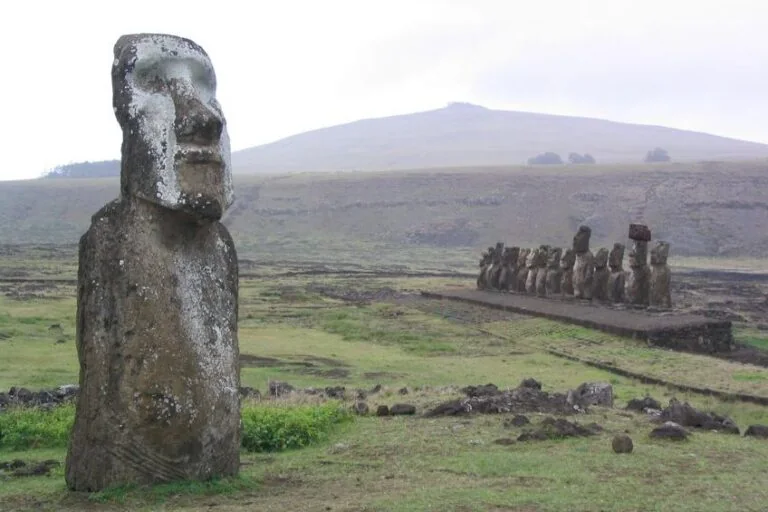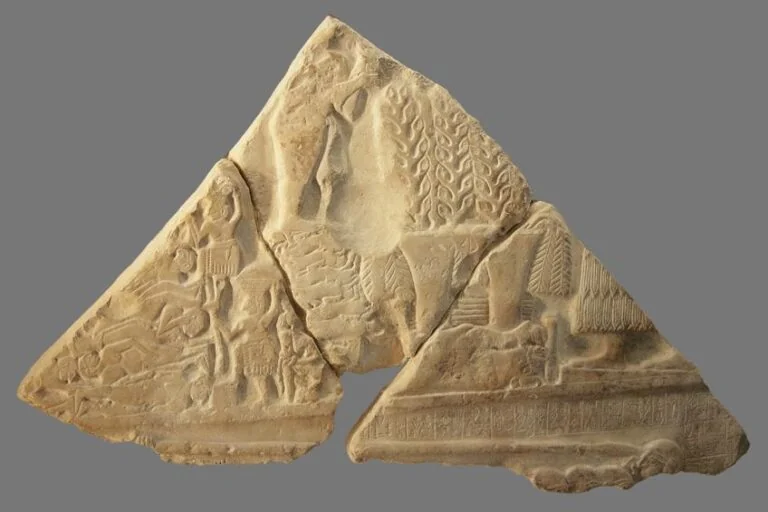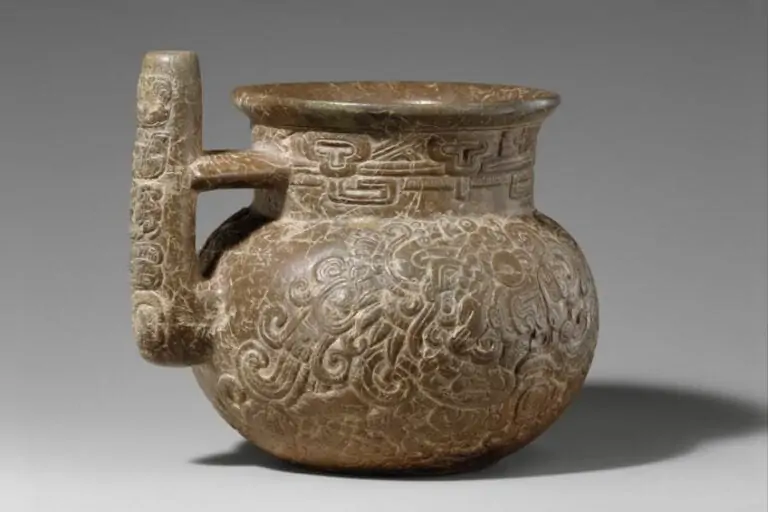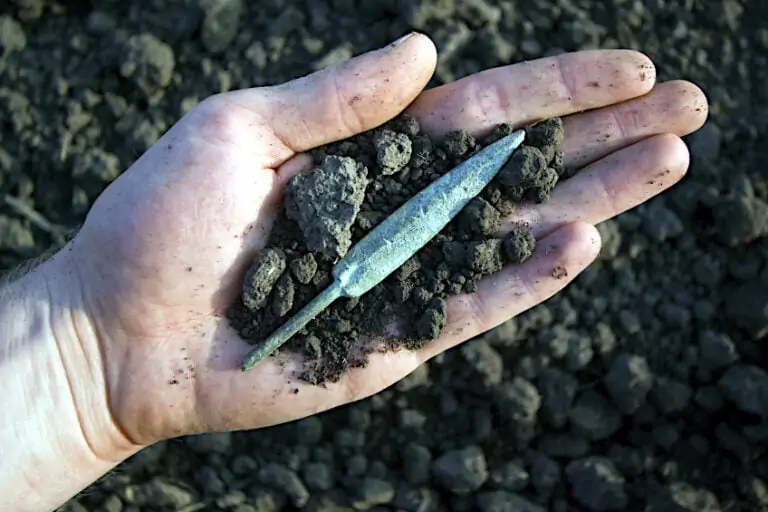Egyptian Weapons – Ancient Egyptian Weaponry and Armor
If you’ve ever attended a history class or watched a movie in the last three decades, then you’ve probably heard of the ancient Egyptian people. Their culture is considered amongst some of the most advanced of the ancient world, and both their artifacts and infrastructure ignited a curiosity and passion for world history in hundreds of thousands of people. However, not many people know of the incredible weapons produced by the Egyptian people and how they managed to develop them over time. This being said, let’s have a look at some ancient Egyptian weapons, how they were produced, and how each iteration differed from the next.
Contents
Earliest Ancient Egyptian Weapons
It probably won’t surprise you to hear that early ancient Egyptian weapons were pretty basic even by ancient standards. Between 3150 and 2613 BCE, ancient Egyptian weapons consisted of short-range melee weapons that were created from readily available materials. These were primarily things like spears, stone maces, and good old-fashioned daggers.
The development of the spears and daggers did not see much improvement or innovation as time went on though.
One of the most notable changes to the dagger and spear tips in particular was a change from flint tips/blades to the more durable copper ones. This change took place after the dynastic period began in ancient Egypt. This makes sense, considering that the primary weapon carried by any ancient Egyptian soldier would have been a spear, with their secondary weapon being their dagger or combat knife. Unlike other ancient societies the ancient Egyptians did not have metal shields, instead opting for the lighter reed or papyrus shield.
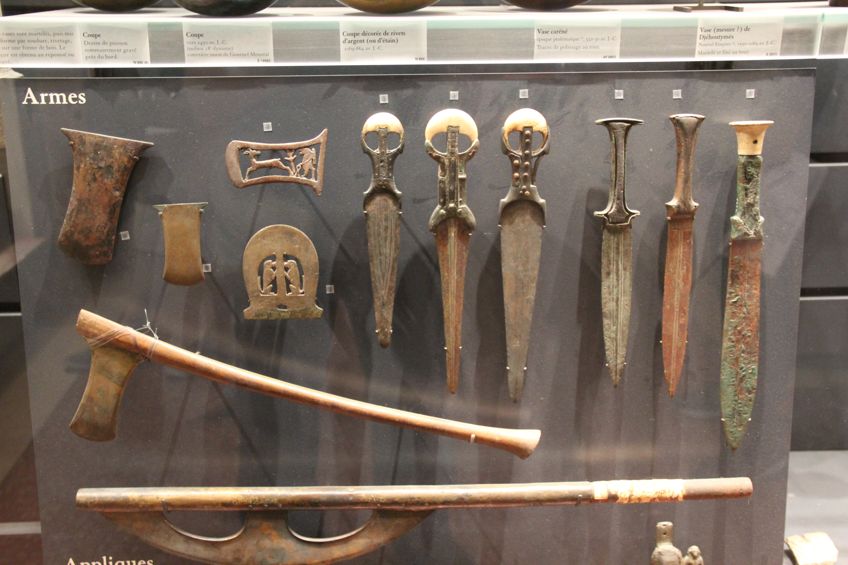 Ancient Egypt Bronze Axes & Daggers (c 1550 –1458 B.C); Gary Todd from Xinzheng, China, CC0, via Wikimedia Commons
Ancient Egypt Bronze Axes & Daggers (c 1550 –1458 B.C); Gary Todd from Xinzheng, China, CC0, via Wikimedia Commons
Even though there was a noticeable change from flint spear and dagger tips to bronze ones during the dynastic period, it seems that flint spear tips and daggers were still easier to come by, ensuring that this older style of weapons would still be pervasive throughout ancient Egyptian civilizations and ancient battlefields. Aside from these melee weapons, the ancient Egyptians also dabbled in the use of long-range weapons. The long-range might have been a bit of stretch, but they did have “traditional” bows and arrows that allowed them to engage the enemy without having to put themselves at risk.
However, these are believed to have only worked at relatively close range, even by ancient Egyptian weapons standards. To make matters a bit worse for Egyptian citizens that were sent to battle, the archers tasked with operating these bows were almost entirely untrained and pulled from the lowest casts of ancient societies to serve on the front lines. The conditions these soldiers were sent to serve in were not any better than their skills or gear.
You see, when Egyptian history reached the era known as the middle kingdom, that can be summarised as a time in history when private individuals had more power than the king himself. These individuals, known as “nomarchs”, were able to send conscripts to the battlefield and even extend their sphere of influence to other facets of governments. After all, he who has the gold makes the rules!
The Middle Kingdom Army of Ancient Egypt
The age of the middle kingdom was an era of great improvement upon previous eras of Egyptian warfare and military. Once Amenemhat I rose to power there was a colossal improvement to both the organization of the ancient Egyptian military and the ancient Egyptian weapons they used in combat.
To paint a pretty good picture of how dire things were back in the day, consider the fact that most soldiers were still using simple bows and arrows.
These could not produce adequate potential energy to be lethal at long range, and they weren’t very reliable either. The daggers used by soldiers in combat were blades riveted to a handle, which eventually resulted in the handle splintering and breaking on contact.
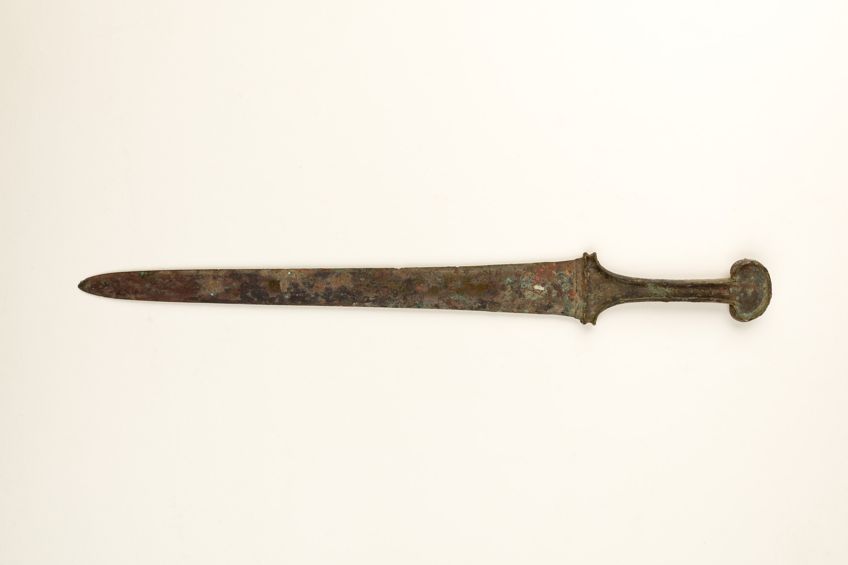 Bronze Sword (c 1550 –1458 B.C); Metropolitan Museum of Art, CC0, via Wikimedia Commons
Bronze Sword (c 1550 –1458 B.C); Metropolitan Museum of Art, CC0, via Wikimedia Commons
The same went for swords used at the time. One of the most effective weapons used at this point in time was the Egyptian battle axe. These weapons consisted of a crescent blade attached to a long wooden handle. This axe (like most other axes) needed to be operated with both hands, with the advantage being that it could be swung both ways when engaging the enemy.
This would have been much more effective compared to the standard issue sword at the time.
As for the combat gear of the soldiers, there isn’t really much to speak of. Even though ancient Egyptian weapons were serviceable, there was still quite a bit to be desired when it came to protective garb for the soldiers. Both archers and soldiers were equipped with a leather breastplate and skirt, which offered little to no protection against projectile weapons.
Hyksos People and the Change of the Egyptian Military
While Egypt had a united military and a decent leadership regime at this point, they entered a period of infighting, and their progress began to dwindle dramatically. At this point, a society either evolves organically, falls apart, or gets much-needed cultural influence from an outside force. Thankfully for the ancient Egyptians, the latter came to pass. The Hyksos are believed to have traded with the ancient Egyptian people for quite a while before they were allowed to settle on the outskirts of Egypt by rulers at the time. The Hyksos people hail all the way from Western Asia, and therefore had access to and knowledge of weaponry and schematics the ancient Egyptians could have never dreamed of.
Since they were permitted to stay in Egyptian territory, an exchange of knowledge, culture, and ultimately weaponry ensued. Now the Egyptian people were privy to solid bronze weaponry, different casting methods, various blade configurations, and armor capable of protecting them from projectile weapons like bows and arrows.
The Horse-Drawn Chariot
Further notable improvements that were made to the Egyptian people’s lives by the arrival of the Hyksos was the introduction of the horse-drawn chariot for combat applications. Believe it or not, the ancient Egyptians were not privy to this technology before the arrival of the Hyksos people, and it greatly improved their combat effectiveness in the long run.
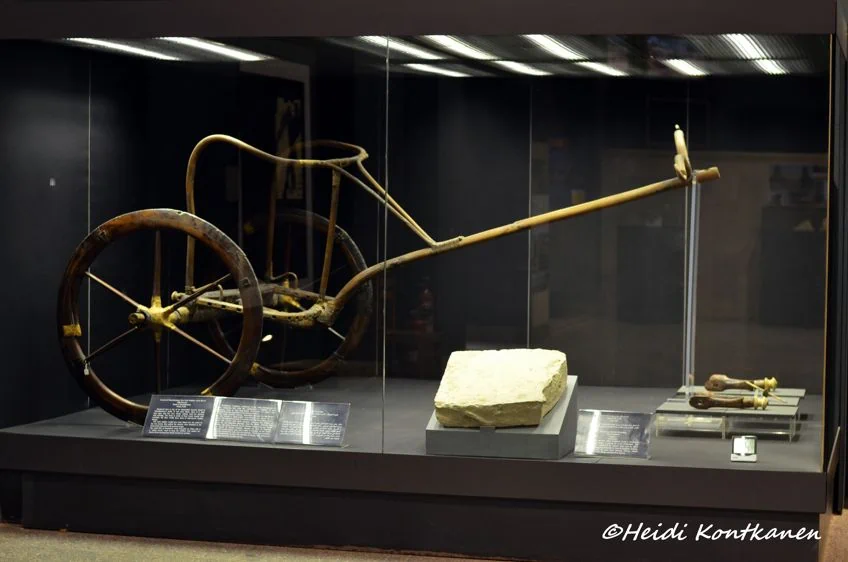 Chariot of Tutankhamun (c 1332-1323 BC); Heidi Kontkanen, CC BY-SA 2.0, via Wikimedia Commons
Chariot of Tutankhamun (c 1332-1323 BC); Heidi Kontkanen, CC BY-SA 2.0, via Wikimedia Commons
The Composite Bow
While they aren’t anything like the compound bows you and I know today, they were a significant improvement upon the traditional bow and arrow setup used by the ancient Egyptians up to this point. These used a wooden bow that was supplemented with animal sinew and material.
This allowed the bow to store more energy and therefore allowed the arrow to traverse larger distances.
The Khopesh Sword
A weapon that really made an improvement in the armaments of the ancient military was the introduction of the Khopesh sword. Unlike the straight blade riveted into a wooden handle that the Egyptians had used before, the Khopesh was a curved blade (resembling a sickle) cast entirely of bronze, giving it better rigidity and therefore a superior force transfer upon contact with the enemy.
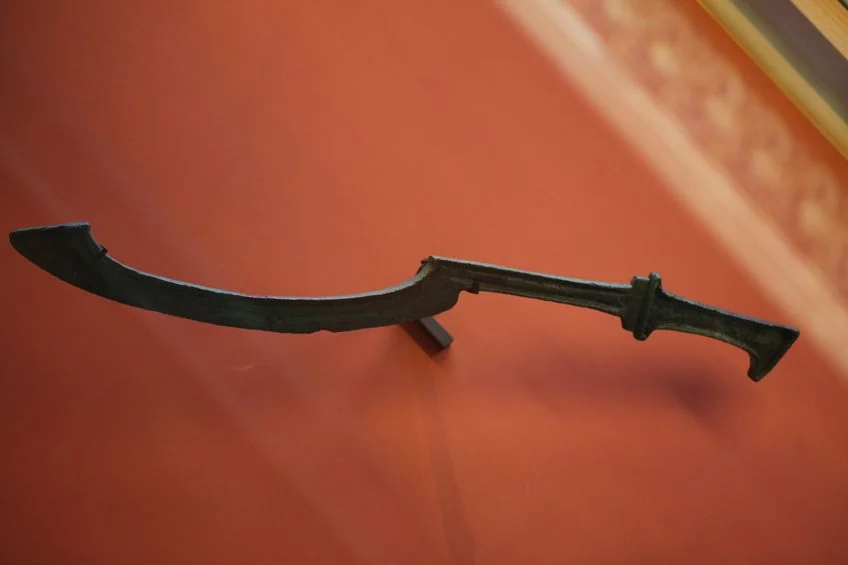 Khopesh sword dedicated to Ramasses II-E (c 1279 – 1213 BC); Louvre Museum, CC BY-SA 2.0 FR, via Wikimedia Commons
Khopesh sword dedicated to Ramasses II-E (c 1279 – 1213 BC); Louvre Museum, CC BY-SA 2.0 FR, via Wikimedia Commons
The Bronze Tip Spear
Arguably the best evolution of ancient Egyptian weaponry would have to be the bronze-tipped spear. This was fundamentally the same as the flint-tipped ones, but the addition of the bronze tip meant that spear tips not only lasted longer but were able to penetrate deeper and be thrown further than their flint-tip predecessors. This was of particular importance due to the fact that the spear was an integral part of any ancient army fighting force, as it allowed them to engage the enemy at a greater distance.
This new and improved spear allowed for reduced risk to the soldiers using them while increasing the probability of a killing blow.
The Javelin
There are very few weapons in the ancient world that are quite as effective as the javelin, especially against an armored enemy. These bronze, diamond-shape-tipped javelins were essentially hand-thrown projectiles capable of penetrating enemy armor and causing extensive damage to anyone housed with it. One of the major selling points of these javelins aside from the devastation they could cause was the fact that they could be retrieved and reused, unlike arrows. This led to Egyptian infantrymen carrying these medium-sized javelins like spears in a quiver into battle, allowing them to throw multiple javelins and retrieve them once the skirmish had ended.
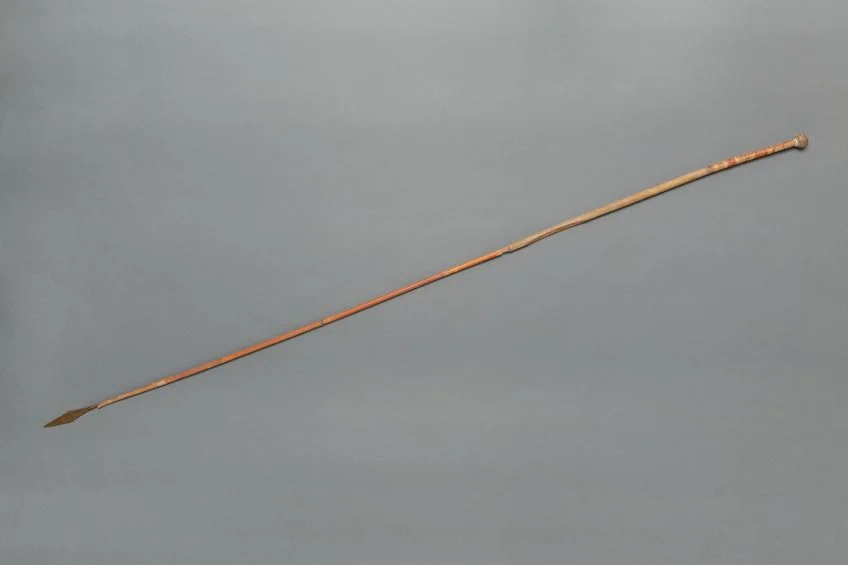 The hilt of a Javelin (c 1479 –1458 B.C.); Metropolitan Museum of Art, CC0, via Wikimedia Commons
The hilt of a Javelin (c 1479 –1458 B.C.); Metropolitan Museum of Art, CC0, via Wikimedia Commons
New Bronze Swords
As we mentioned previously, the initial design of the Egyptian short sword left much to be desired. The design was essentially a blade that had been poorly riveted to a handle, resulting in the blade breaking if stuck hard enough. Upon the introduction of the new sickle-like blade, both durability and combat effectiveness would have improved tenfold. The new blades were cast entirely of bronze, making them denser and less likely to falter when stressed. However, bronze is still a relatively self-metal, so blade-on-blade contact would have been avoided. The Egyptians also developed new short swords, some pure bronze, and others simply an improved riveted design.
Short swords would have been used for close-quarters combat, whereas the longer sickle-like blades would have been used to slice enemies and shields at medium range.
New Battle Axe
One of the most versatile weapons in the ancient Egyptian arsenal besides the Javelin would have to be the battle axe. These were typically carried slung over the shoulder or in the waistband to ensure easy deployment. The new battle axe simply had an improved design, maintaining its bronze blade with an improved alloy and handle design. The battle axe took on further evolutions as the ancient Egyptians encountered new enemies. The Hittite and Syrian armies used leather armor in battle, leading the ancient Egyptians to develop increasingly sharper blades to both penetrate the armor and hack away the shields that their enemies were holding at the time.
 Battle Ax of Baki (c 1504 –1447 B.C.); Metropolitan Museum of Art, CC0, via Wikimedia Commons
Battle Ax of Baki (c 1504 –1447 B.C.); Metropolitan Museum of Art, CC0, via Wikimedia Commons
The Fierce Egyptian Weapons of the New Kingdom
In the equivalent of you teaching someone how to use a firearm and them turning around and shooting you with it, the Egyptians would eventually use the Hyksos people’s weaponry knowledge against them. Why? Well, the Hyksos people began to occupy large territories and several ports in and around Egypt, and since the Egyptians had never been occupied before, they decided to do something about it.
The Hyksos people at this point had taken over around three ports on the coast of Egypt at the time.
This, in addition to the presence of the Nubians in upper Egypt, meant that the Egyptian hierarchy was losing territory quickly. Thebes and the upper portions of Egypt were the only lands left that were still under the control of the Egyptian ruling class.
 Ancient Knife (c 1569 – 1081 BC); Los Angeles County Museum of Art, Public domain, via Wikimedia Commons
Ancient Knife (c 1569 – 1081 BC); Los Angeles County Museum of Art, Public domain, via Wikimedia Commons
Ahmose I of Thebes took it upon himself to reclaim the aforementioned land and did so quite swiftly. With considerable effort and the implementation of shock combat, Ahmose I was able to drive the Hyksos occupiers from Egypt, effectively gaining the popularity necessary to secure the support of various parties, and eventually unify Egypt under his rule.
This defeat seems to have broken the spirit of the Hyksos people.
How exactly? Weapons found after this period of defeat seem to indicate the Egyptians not only outgrew the weapons given to them by the Hyksos, but the defeat seemed to have caused the Hyksos people to abandon creating weapons for combat applications entirely, instead making weapons for ritualistic purposes.
Expansion of the Egyptian Empire
Once he had dealt with the Hyksos people, Ahmose I sought to expand the Egyptian empire using the same weapons that had been given to them by the Hyksos people. Ahmose I then began a campaign that would see Egypt’s rule expand significantly and would continue to expand even after Ahmose I’s rule ended through his successors.
Why the need for all of this expansion you ask? Well, aside from having more land, the occupation the Egyptian people experienced through the Hyksos people had left them with a fear of invasion, and the ultimate goal of this era of expansion was to ensure that there was as much land between the Egyptian capital and potential invaders as humanly possible.
As the expansion during the era of the New Kingdom went on, the Egyptians seemed to have learned that they could learn a lot from enemies they encountered along the way. As they did with the Hyksos people, they eventually learned to adapt and integrate weaponry, armor, and even battle strategies of foreign powers they encountered into the arsenal.
During the campaign of Pharaoh Thutmose III, the Egyptian people had come into (mostly hostile) contact with the Hittites and Syrian people. Contact with these people had allowed them to eye out even more advanced weaponry and armor that they never would have encountered if they had not embarked on their initial mission of expansion.
If you’re wondering what exactly they managed to learn, some of the most useful tools the Egyptians managed to procure were the triangular bow and chainmail-style armor. They also managed to improve their knowledge and skill with metallurgy, allowing them to produce better-quality bronze weapons and even integrate tin and copper into their tools.
 Armor Scales (c 589–570 B.C); Metropolitan Museum of Art, CC0, via Wikimedia Commons
Armor Scales (c 589–570 B.C); Metropolitan Museum of Art, CC0, via Wikimedia Commons
Essentially, this became the golden age of the Egyptian military. Not only were their weapons and army improved compared to the earlier iterations, but they managed to organize their units into chariot units, frontline infantry units, and archery units too! These units were even given their own names based on various deities, and uniforms to boot.
The Iron Age and Decline of the New Kingdom
We mentioned previously that the ancient Egyptians were known to learn from the enemies they encountered. During their skirmishes with the Hittite people, they engaged warriors with iron shields, a concept that had eluded the ancient Egyptians up until this point.
However, upon their victory against these people, they employed many Hittite forgers to create such shields and weapons for them.
This would come to be known as the great Iron age of the ancient Egyptian empire, but it would not last for long, unfortunately. Once the Hittite forgers were employed, massive iron forgers were created to facilitate the production of both iron shields and swords for the new Egyptian army, but there was a problem with the plan from its inception.
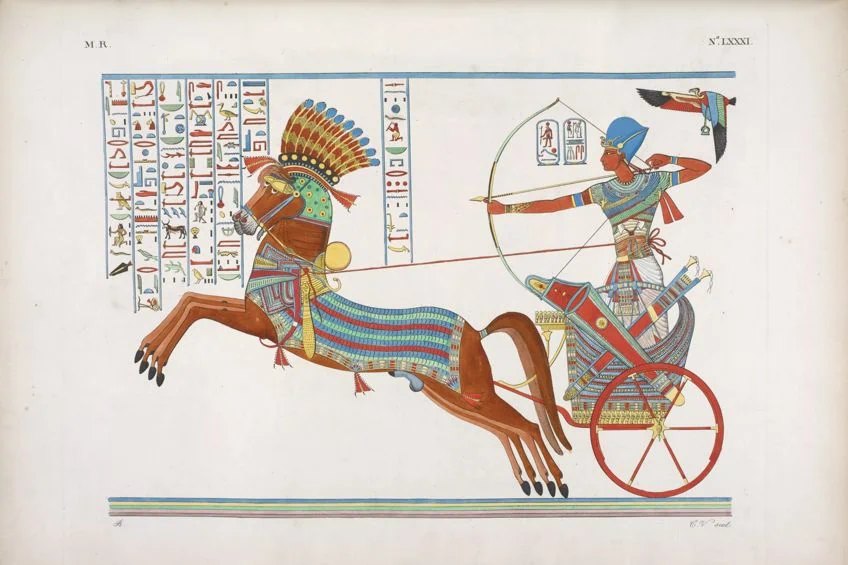 For Ramses III (1832) Scanned Image by NYLP; Scan by NYPL, Public domain, via Wikimedia Commons
For Ramses III (1832) Scanned Image by NYLP; Scan by NYPL, Public domain, via Wikimedia Commons
Iron requires the burning of wood in order to get the furnaces up to temperature. In case you didn’t already know this, Egypt is in the middle of a desert, nowhere near forested areas big enough to sustain the burning of these furnaces. This being said, only a small portion of soldiers would receive iron weapons, and eventually, the refinement and use of iron would cease completely.
At this point, a lack of leadership saw the ancient Egyptian society and by proxy, its army, decline heavily. This in combination with attacks by the Sea People and Libyans would see the newly united kingdom fall to ruin once more, ending the age of the New Kingdom, and the great weaponry renaissance of ancient Egypt.
Now that you know what weaponry was like in ancient Egypt, how they learned about new weapons by coming into contact with other societies, and how this led to both the greatest and lowest points in ancient Egyptian military history, it’s time for you to get out there and put your newfound knowledge to the test. Remember that ancient societies learned and evolved by interacting with one another, and that a lot can be learned simply by engaging with the world around you.
Frequently Asked Questions
What Is Ancient Egyptian Weaponry?
Ever wondered about ancient Egyptian weaponry? Well, like most ancient societies, they focused on short-range projectile weapons, close-range melee, and bladed weaponry. The typical Egyptian infantry soldier carried a spear, javelin, short sword, and wooden shield covered in animal hide.
What Was the Ancient Egyptian Sword?
The ancient Egyptian sword was initially a bronze blade that was riveted to a wooden handle. When the ancient Egyptians encountered the Hittite people, they switched to a curved blade consisting entirely of forged bronze that resembled a sickle.
Was the Ancient Egyptian Military Strong?
The ancient Egyptian military went through periods of disorganization, outdated weaponry, and immense organized strength. The organization and weapons of the ancient Egyptian military changed as they encountered new people and adapted their tactics and weaponry accordingly.
Did the Ancient Egyptians Have Armor?
Ancient Egyptians did have armor. Egyptian armor of the time consisted of primarily leather breastplates, belts, and skirts. However, Egyptian armor changed when they entered their iron age, producing small amounts of iron armor and shields.

I am deeply passionate about history and am constantly fascinated by the rich and complex stories of the past. As the editor-in-chief of learning-history.com, I have the opportunity to share this passion with a wide audience through the creation and distribution of engaging and informative content about historical events, persons, and cultures. Whether it’s through writing articles and blog posts or creating videos or podcasts, I strive to bring the past to life in a way that is both accurate and enjoyable. My expertise in history, combined with my strong writing and communication skills, allows me to effectively communicate complex historical concepts and make them accessible and interesting to a wide range of readers. I am truly grateful for the opportunity to share my love of history with others through my work on learning-history.com.

